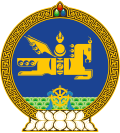China–Mongolia relations
 | |
Mongolia |
China |
|---|---|
| Envoy | |
| Ambassador Tuvshin Badral | Ambassador Shen Minjuan |
China–Mongolia relations (
Country comparison
| Common name | China | Mongolia |
|---|---|---|
| Official name | People's Republic of China | Mongolia |
| Coat of arms | 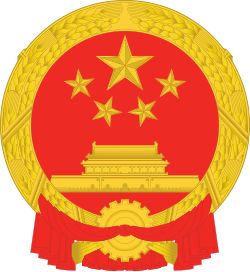
|

|
| Flag | 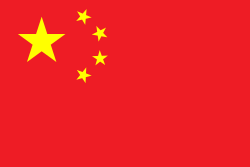
|
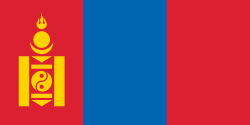
|
| Anthem | ||
| Area | 9,596,961 km2 (3,705,407 sq mi) | 1,564,116 km2 (603,909 sq mi) |
Population
|
1,409,050,000 | 3,227,863 |
Population density
|
145/km2 (375.5/sq mi) | 2.07/km2 (5.4/sq mi) |
| Capital | Beijing (21,893,095) | Ulaanbaatar (1,612,005) |
Largest city
|
Shanghai (26,317,104) | |
| Government | Unitary one-party socialist republic | Unitary semi-presidential republic |
| First leader | Chairman Mao Zedong | President Punsalmaagiin Ochirbat |
| Current leaders | President Xi Jinping[a]
Premier Li Qiang
|
President Ukhnaagiin Khürelsükh |
| Established | 21 September 1949 (People's Republic declared)
1 October 1949 (Proclamation of the People's Republic) 4 December 1982 ( current constitution )
|
13 February 1992 (current constitution) |
| Official languages | Standard Chinese | Mongolian |
| Currency | Yuan | Tögrög
|
| GDP (nominal) | $18.273 trillion (2024)[1] | $16.908 billion (2023) |
| External debt (nominal) | $1.843 trillion (2018 Q4) | $25.2 billion (2017) |
| GDP (PPP) | $37.072 trillion (2024)[2] | $52.467 billion (2023) |
| GDP (nominal) per capita | 12,969 (2024)[3] | $6,666 (2024) |
| GDP (PPP) per capita | $26,310(2024)[4] | $20,514 (2025) |
| Human Development Index | 0.790 (high)[5] | 0.737(high)[6] |
Expatriates
|
~6,300,000 Mongolians living in China
|
~40,000 Chinese living in Mongolia
|
| Foreign exchange reserves | 3,088,000 (millions of USD) | 3,697 (millions of USD) |
Military expenditures
|
$177.6 billion (1.9% of GDP) (2019) | $210 million (1.5% of GDP) (2019) |
| Military personnel | 3,205,000 (0.23% of population)
|
170,000 (5.2% of population)
|
| Army size | People's Liberation Army Ground Force (2019)
|
Mongolian Ground Force (2019)
|
| Air force size | People's Liberation Army Air Force
|
Mongolian Air Force
|
| Navy size | People's Liberation Army Navy (2025)
Total naval strength: 788 ships
|
No Navy |
| Nuclear warheads
active/total |
500 (2024)[7] | 0 |
Background
The Han and Mongol (as well as their ancestors, the Proto-Mongols) peoples have been in contact with each other for millennia.
Throughout history, polities in the Central Plains and the Mongolian Plateau have had complicated relations. The Great Wall was constructed to ward off attacks by nomads from the north, notably during the Han and Ming dynasties. The Tang dynasty, following its defeat of the Xueyantuo, established the Protectorate General to Pacify the North in 647 to rule the Mongolian Plateau.
In 1271, the Mongols under
The

Following the end of World War II, the Republic of China, led by the Kuomintang, was forced to formally accept Outer Mongolian independence under Soviet pressure. Recognition of Mongolian independence was stipulated in the Sino-Soviet agreement of August 14, 1945. The Chinese government officially recognized Mongolian independence in January 1946.[13] In 1949, the Communists won the Chinese Civil War and maintained the policy of recognizing Mongolia's independent status.
Cold War
The People's Republic of China established
Recent period
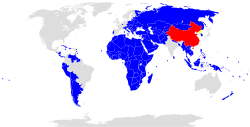
In the post-
Mongolia participates in the Belt and Road Initiative.[20] The BRI has been an important factor in the growing Mongolian view that China is an economic partner rather than a threat to its territorial integrity.[21]: 208 Mongolia cooperates in the development of the China-Mongolia-Russia Economic Corridor, one of the six major land corridors of the BRI.[22]: 39 In January 2024, Mongolia stated that it seeks to institute a summit where the three countries can further develop economic opportunities, including the corridor.[23]
In January 2024, Mongolian Prime Minister Luvsannamsrai Oyun-Erdene described relations between Mongolia and China as at their highest level and described the two countries as working towards a comprehensive strategic partnership.[23]
The Gashuunsukhait–Gantsmod railway is a 19.5 km cross-border extension of the existing Sino-Mongolian rail network, first proposed in 2009. In May 2025, Mongolia’s parliament ratified a strategic partnership with China to construct the link, work formally beginning on 14 May 2025, with the aim of eliminating the need for truck haulage across the border. Once operational, the new connection was expected to increase annual coal transport capacity by 30 million tonnes, facilitate the expansion of the Tavan Tolgoi coal mine, and, if later integrated with the Khangi–Mandal and Shiveekhüren–Sekhen crossings, could raise Mongolia’s total coal-export capacity to 120 million tonnes by 2030. Construction was set to be overseen by Mongolia’s state-owned Erdenes-Tavantolgoi JSC and China Energy.[24]
See also
- China–Mongolia border
- Mongolia-Taiwan relations
- Battle of Baitag Bogd
- Vostok 2018
- 2015 China Victory Day Parade
Notes
- ^ The head of government of China is the Premier, while the President is legally a ceremonial office and has no real power in China's political system. However, the General Secretary of the Chinese Communist Party (top position) has always held this office since 1993 except for the months of transition, and the current paramount leader is Xi Jinping.
References
- ^ ""World Economic Outlook database: October 2024"". China Briefing News. 2024-01-18. Retrieved 2024-11-22.
- ^ "Report for Selected Countries and Subjects". IMF. Retrieved 2024-11-22.
- ^ ""World Economic Outlook database: October 2024"". www.macrotrends.net. Retrieved 2024-11-22.
- ^ "World Economic Outlook database: October 2024". www.worldometers.info. Retrieved 2024-11-22.
- ^ "China | Data Futures Exchange". data.undp.org. Retrieved 2024-11-22.
- ^ "Mongolia 2023 IFRC network country plan (MAAMN001) - Mongolia | ReliefWeb". reliefweb.int. 2023-01-17. Retrieved 2024-11-22.
- ^ Kristensen, Hans; Norris, Robert (November 2018). "Status of World Nuclear Forces". Federation of American Scientists. Archived from the original on 18 June 2015. Retrieved 25 July 2019.
- ^ "Mongolia's National Revolution of 1911 and the last emperor of Mongolia – VIII Bogdo Jetsundamba Khutukhtu" (PDF).
- ISBN 9780742578159.
- ISBN 9789629373214.
- ISBN 9789629372910.
- ISBN 978-5-87317-692-2
- ^ "China/Mongolia (1911-1946)". University of Central Arkansas. Department of Government, Public Service, and International Studies. Retrieved 2024-02-14.
On August 14, 1945, the Chinese government agreed to recognize the independence of Mongolia if Mongolians approved of independence from China in a referendum. Mongolians voted overwhelmingly for independence in a referendum held on October 20, 1945. The government of the Republic of China formally recognized the independence of Mongolia on January 5, 1946.
- ^ "China-Mongolia Boundary" (PDF). International Boundary Study (173). The Geographer, Bureau of Intelligence and Research: 2–6. August 1984. Archived from the original (PDF) on 2006-09-16. Retrieved 2008-06-16.
- ^ a b c "Mongolia-China relations". Library of Congress. Archived from the original on 2017-08-01. Retrieved 2008-06-15.
- ^ "Wilson Center Digital Archive".
- ISBN 978-1-5036-3415-2.
- ^ a b c ""Pan-Mongolism" and U.S.-China-Mongolia relations". Jamestown Foundation. 2005-06-29. Archived from the original on 2015-12-27. Retrieved 2013-04-07.
- ^ a b "China breathes new life into Mongolia". Asia Times. 2007-09-12. Archived from the original on 2007-10-11. Retrieved 2008-06-16.
- ^ Graceffo, Antonio (15 July 2020). "Mongolia and the Belt and Road Initiative: The Prospects for the China-Mongolia-Russia Economic Corridor". Jamestown Foundation. Retrieved 2020-07-16.
- ISBN 978-1-03-239508-1.
- ISBN 9780300266900.
- ^ a b "Between China and Russia, landlocked Mongolia eyes summit to enhance ties as geopolitical pressures mount". Yahoo Finance. 2024-01-24. Retrieved 2024-04-19.
- ^ Stutt, Amanda (2025-05-16). "Mongolia-China railway extension to increase coal transport capacity by 30Mt". MINING.COM. Retrieved 2025-05-19.
Further reading
- Ginsburg, Tom. "Political reform in Mongolia: between Russia and China." Asian Survey 35.5 (1995): 459–471.
- Paine, Sarah CM. Imperial rivals: China, Russia, and their disputed frontier (ME Sharpe, 1996).
- Perdue, Peter C. "Military Mobilization in Seventeenth and Eighteenth-Century China, Russia, and Mongolia." Modern Asian Studies 30.4 (1996): 757–793.
- Perdue, Peter C. "Boundaries, maps, and movement: Chinese, Russian, and Mongolian empires in early modern Central Eurasia." International History Review 20.2 (1998): 263–286.
- Reeves, Jeffrey. "Rethinking weak state behavior: Mongolia’s foreign policy toward China." International Politics 51.2 (2014): 254–271.

